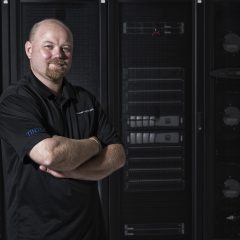We began to virtualize our Datacenter in 2003. We were struggling with the same problems as so many other companies at that time… The size of our Datacenter.
The Datacenter was about filled. We had problem with cooling and with getting sufficient power. The Datacenter was build for Tower Servers and at some point the Tower Servers was switched with Rack Servers introducing the challenge with getting power and cooling.
The solution…. VMware ESX now evolved to VMware vSphere http://www.vmware.com/products/vsphere.html
We started with virtualizing 35 of our then 150 servers using 4 physical servers. One of the challenges at that time is oddly enough one we sometimes runs into today. If an application doesn’t perform well the answer from the providers is that their software doesn’t perform well because we are running it on VMware. We have over the years used a lot of time trying to prove that the performance problem is not coursed by our Infrastructure but by the different applications. For some Applications we even had to hire external specialists to back up our claim.
Today we are running almost fully virtualized. We have about 500 virtual Servers and about 500 virtual Desktops and that with a smaller Operations Staff than we had in 2003. The only workload not running virtualized is a system that requires Analog phone lines. Everything else is running on vSphere. Not only are we saving a lot of money on power and cooling but we have gained an Infrastructure was is more stable and a lot more flexible that the one we had before. From taking up to a month to deliver a server we can now do it in 15 minutes.
What about the challenge with proving that our Infrastructure is not the course for performance problems? Well once again VMware to the rescue. The solution for us was to begin using Operations. Available as vSphere with Operations or as vRealize Operations you gain full visibility of how the Infrastructure performs and where you have bottlenecks. If a user complains about performance you can quickly determine if you have a problem with the Infrastructure or if it is software related. This makes troubleshooting a lot easier. As an added bonus it makes it easier to estimate the needs for sizing the Hardware in the Datacenter. You can see the required size and performance needs for CPU, Memory and Storage.

For us the implementation of vSphere and Operations has been a huge success and even with a smaller Operations staff and a lot more servers than then we started we have a Datacenter that is stable and flexible and allow us to quickly respond to the Business demands.
